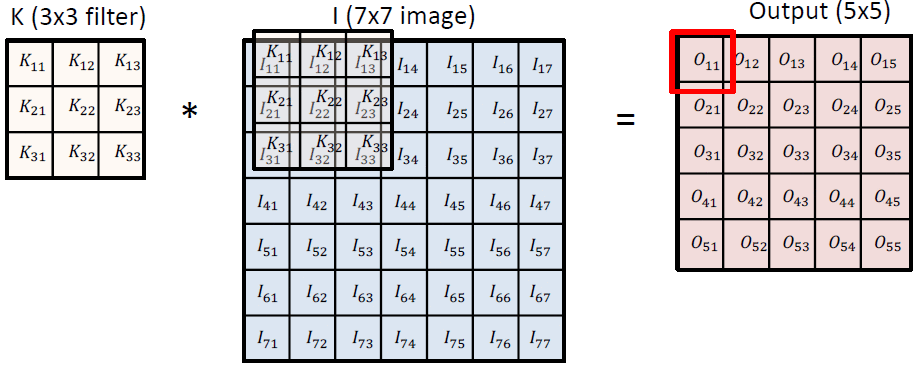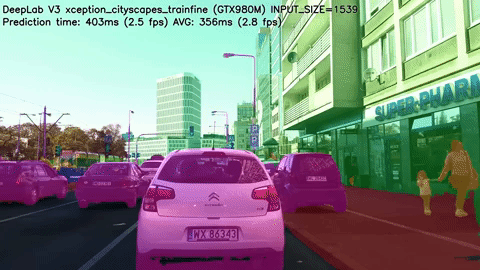Contents
ILSVRC라는 Visual Recognition Challenge와 대회에서 수상을 했던 5개 Network 들의 주요 아이디어와 구조에 대해 배웁니다. 또한, CNN(Convolutional Neural Network)에서 가장 중요한 연산은 Convolution 입니다.
CNN에 대한 공부를 하기 전에 Convolution의 정의, convolution 연산 방법과 기능에 대해 배웁니다. 그리고 Convolution, 입력을 축소하는 Pooling layer, 모든 노드를 연결하여 최종적인 결과를 만드는 Fully connected layer 로 구성되는 기본적인 CNN(Convolutional Neural Network) 구조에 대해 배웁니다.
마지막으로 Computer Vision 에서 CNN을 이용한 분야를 알아보고자 합니다. Semantic segmentation의 정의, 핵심 아이디어에 대해 배웁니다. Object detection의 정의, 핵심 아이디어, 추가적으로 종류에 대해 배웁니다.
1. Modern CNN - about 1x1 convolution
Network list
- AlexNet
- 최초로 Deep Learning을 이용하여 ILSVRC에서 수상.
- VGGNet
- 3x3 Convolution을 이용하여 Receptive field는 유지하면서 더 깊은 네트워크를 구성.
- Receptive field 참고 자료
- GoogLeNet
- Inception blocks 을 제안.
- ResNet
- Residual connection(Skip connection)이라는 구조를 제안.
- h(x) = f(x) + x 의 구조
- DenseNet
- Resnet과 비슷한 아이디어지만 Addition이 아닌 Concatenation을 적용한 CNN.
1.1. ILSVR
Imagenet Large-Scale Visual Recognition Challenge
- classification / detection / localization / segmentation
- 1000diff categories
-
1 million images
year Error Rate 2010 28% 2011 25% 2012 16% 2013 11% 2104 6% 2015 3.5% Human about 5.1%
1.2. AlexNet
key ideas
- ReLU activation
- 2 GPUs
- local response normalization, overlapping pooling
- data augmentation
- dropout
relu activation
- preserves properties of linear model
- easy to optimize with gradient descent
- good generalization
- overcome the vanishing gradient problem
1.3. VGGNet

key ideas
- 3 X 3 convolution. filter의 사이즈를 줄이기 시작했다.
-
why?

- 3 by 3 filter를 두 번 사용하는 것은 5 by 5 filter를 한 번 사용하는 것과 I/O의 관점에서 별 차이가 없다.
- 하지만 파라미터의 수를 계산해보면 약 10만개 가량이 차이난다.
- 이는 계산속도와 generalization performance에 영향을 끼친다.
1.4. Googlenet

inception blocks
-
what are the benefits of the
inception block?- reduce the number of parameter
-
How?
- recall how the number of parameters is computed
-
1 X 1 convolution can be seen as channel wise dimension reduction,
즉 채널 방향으로 차원을 줄일 수 있다.

- 앞서 설명한 “작은 사이즈의 filter를 여러번 사용하는 방법”과 유사하게,
layer는 깊게 만들고 I/O size는 유지하면서 파라미터의 사이즈는 줄일 수 있다. - 약 30% 가량으로 파라미터가 줄어든 모습을 확인할 수 있다.
benefit of 1,1 conv
- 1x1 convolution enables about 30% reduce of the number of pararmeters
1.5. comparing
# of parameters?
AlexNet(8-layers): 60MVGGNet(19-layers): 110MGoogLeNet(22-layers): 4M
1.6. ResNet
deeper neural networks are hard to train
- overfitting is usually caused by an excessive number of parameters
- bus not in this case.
idea
-
add an identity map(skip connection)


- skip-connection을 사용하지 않을 때(좌측)는 더 깊은 신경망의 error가 더 큰 모습을 보여준다. 하지만, ResNet의 경우(우측), 신경망의 깊이가 깊어졌음에도 불구하고 얕은 신경망에 비해서 더 낮은 error율을 보여준다.
이는 신경망이 깊어졌음에도 학습을 제대로 하고 있다는 것을 보여준다. - add an identity map after nonlinear activations:
- 차원을 맞춰주기 위해 1x1 conv를 이용한다.
- bottleneck architecture
History of Convolutional Network
 더 좋은 성능을 발휘하는 모델일 수록 파라미터의 수는 작아지는 방향으로 발전해왔다.
더 좋은 성능을 발휘하는 모델일 수록 파라미터의 수는 작아지는 방향으로 발전해왔다.
1.7. DenseNet
DenseNet uses concatenation instead of addition

- (좌측) ResNet의 경우, skip-connection을 수행할 때
+pairwise하게 더해준다. - (우측) DenseNet의 경우, skip-connection을 수행할 때
concat을 통해 나열해준다. -
이 때, 단순히 concat을 반복하게 되면 layer가 깊어질수록 아래와 같이 파라미터가 중첩되고, 마지막 층에 가서는 그 수가 기하급수적으로 늘어나게 된다.

Dense Block
- Each layer concatenates the feature maps of all preceding layers
- the number of channels increases geometrically.
이를 해결하기 위해 아래와 같은 Transition block을 Dense block과 반복하며 파라미터를 조절해준다.
Transition block
- batchnorm -> 1x1conv -> 2x2 Avgpooling
-
Dimension reduction

1.8. Summary
key takeaways
VGG: repeated 3$\times$3 blocks
GoogLeNet: 1$\times$1 convolution
ResNet: skip-connection
DenseNet: concatenation
2. What is Convolution?
CNN(Convolutional Neural Network)에서 가장 중요한 연산은 Convolution 입니다. CNN에 대한 공부를 하기 전에 Convolution의 정의, convolution 연산 방법과 기능에 대해 배웁니다. 그리고 Convolution, 입력을 축소하는 Pooling layer, 모든 노드를 연결하여 최종적인 결과를 만드는 Fully connected layer 로 구성되는 기본적인 CNN(Convolutional Neural Network) 구조에 대해 배웁니다.
2.1. Convolution
필터의 모양에 따라서 같은 이미지가 다르게 표현될 수 있다.
 \(\begin{align}
O_{11} = &I_{11}K_{11}+I_{12}K_{12}+I_{13}K_{13}+I_{21}K_{21}+I_{22}K_{22}+I_{23}K_{23}+I_{31}K_{31}+I_{32}K_{32}\\
&+I_{33}K_{33}+bias\\
O_{12} = &I_{12}K_{11}+I_{13}K_{12}+I_{14}K_{13}+I_{22}K_{21}+I_{23}K_{22}+I_{24}K_{23}+I_{32}K_{31}+I_{33}K_{32}\\
&+I_{33}K_{33}+bias\\
O_{13} = &I_{13}K_{11}+I_{14}K_{12}+I_{15}K_{13}+I_{23}K_{21}+I_{24}K_{22}+I_{25}K_{23}+I_{33}K_{31}+I_{34}K_{32}\\
&+I_{34}K_{33}+bias\\
O_{14} = &I_{14}K_{11}+I_{15}K_{12}+I_{16}K_{13}+I_{24}K_{21}+I_{25}K_{22}+I_{26}K_{23}+I_{34}K_{31}+I_{35}K_{32}\\
&+I_{35}K_{33}+bias\\
\end{align}\)
\(\begin{align}
O_{11} = &I_{11}K_{11}+I_{12}K_{12}+I_{13}K_{13}+I_{21}K_{21}+I_{22}K_{22}+I_{23}K_{23}+I_{31}K_{31}+I_{32}K_{32}\\
&+I_{33}K_{33}+bias\\
O_{12} = &I_{12}K_{11}+I_{13}K_{12}+I_{14}K_{13}+I_{22}K_{21}+I_{23}K_{22}+I_{24}K_{23}+I_{32}K_{31}+I_{33}K_{32}\\
&+I_{33}K_{33}+bias\\
O_{13} = &I_{13}K_{11}+I_{14}K_{12}+I_{15}K_{13}+I_{23}K_{21}+I_{24}K_{22}+I_{25}K_{23}+I_{33}K_{31}+I_{34}K_{32}\\
&+I_{34}K_{33}+bias\\
O_{14} = &I_{14}K_{11}+I_{15}K_{12}+I_{16}K_{13}+I_{24}K_{21}+I_{25}K_{22}+I_{26}K_{23}+I_{34}K_{31}+I_{35}K_{32}\\
&+I_{35}K_{33}+bias\\
\end{align}\)
2.2. CNN

CNN consists of convolution layer, pooling layer, and fully connected layer.
- Convolution and pooling layers: feature extraction
- Fully connected layer : decision making (e.g., classification)

필수적이진 않지만, stride와 channel을 보고 파라미터의 크기를 가늠할 수 있어야 한다.
stride와 padding에 대한 설명은 생략하도록 한다.
2.3. Convolution Arithmetic
Padding (1), Stride (1), $3\times 3$ Kernel

결국 Input의 Width와 Height는 convolution 연산을 수행하는 과정에서 발생하는 parameter 수에 상관이 없다.
Kernel size 3$\times$3은 사실 3$\times$3$\times$Channel size이므로 (그림의 파란색 부분) 파라미터는 3$\times$3$\times$128(이전 channel size)$\times$64(변한 뒤의 channel size)가 된다.
3. Computer Vision Applications
Computer Vision 에서 CNN을 이용한 분야를 알아보고자 합니다. Semantic segmentation의 정의, 핵심 아이디어에 대해 배웁니다. Object detection의 정의, 핵심 아이디어, 추가적으로 종류에 대해 배웁니다.
3.1. Semantic Segmentation
문제정의
-
이미지의 모든 픽셀을 분류하는 문제

- Dense classification이라고도 불린다
-
자율주행에 사용되는 핵심 기술이다.

refer :
https://www.jeremyjordan.me/content/images/2018/05/deeplabcityscape.gif
3.1.1. FCN(Fully Convolutional Network)
difference Dense and Fully conv.
- Dense
- 마지막에 tensor를 flatten 한 뒤에 dense layer를 통해 벡터를 일자로 펴준다.
- Fully conv.
- Convolutionalization이라고도 부른다.
- flatten과 dense layer를 없애는 것 자체가 장점이다.
Convolutionalization
-
Dense layer

number of param. : 4 X 4 X 16 X 10 =
2,560 -
Fully conv.

number of param. : 4 X 4 X 16 X 10 =
2,560 -
보이는 것과 같이 파라미터의 수에는 변화가 없다.
특징
- Transforming fully connected layers into convolution layers enables a classification net to output a heat map.
- 즉, 인풋 이미지에 상관없이 네트워크가 돌아가는 것이 특징이다. 또한, output이 커지게 되면 뒷단의 네트워크가 따라서 커진다.
- 왜일 간격이 개같니
FCN
- while FCN can run with inputs of any size, the output dimensions are typically reduced by subsampling.
- So we need a way to connect the coarse output to the dense pixels
Deconvolution(conv transpose)

- 직관적으로는 conv 연산의
역연산이다. - 하지만, 역연산이라는 건 실제로 불가능하다. 예를 들면, 어떠한 두 수를 더해서 10을 만들었다고 할 때, 10을 만드는 두 개의 수는 여러가지이다. 하지만, 거꾸로 10을 만드는 두 수를 찾으라고 한다면 이는 불가능하다.
- convolution을 진행하면서 filter의 정보를 합해 더 작은 feature로 만들기 때문에, 이 방식의 역 연산은 불가능하다.
- 하지만 비슷한 size를 원하기 때문에, 많은 padding을 부여함으로써 이와 같이 deconvoluion 연산을 정의하게 된다.
Result
- 이와 같은 방식을 통해 sementic segmentation task를 진행한다.
3.2. Detection
per pixel이 아닌 bounding box로써 이미지 중 어떠한 부분을 검출하는 분야이다.
3.1. R-CNN

R-CNN (1) tackes an input images, 92) extracts around 2,000 region proposals (using Selective search), (3) compute features for each proposal (using AlexNet), and then (4) classifies with linear SVMs.
23.2. SPPNet
RCNN의 문제는 image의 bounding box를 뽑을 때, 그 모든 patch들을 CNN에 다 통과시켜야 한다는 점이다.

In
R-CNN, the number of crop / warp is usually over 2,000 meaning that CNN must run more than 2,000 times (59s/image on CPU).
However, inSPPNet, CNN runs once.
이미지의 patch를 추출(crop)하고, 이를 사이즈 조절(warp)한 뒤 conv-layer를 통과시키는 R-CNN은 각 patch를 모두 conv에 통과시켜야 했지만, SPPNet의 경우 한 이미지만을 conv에 통과시킨 후, 각 부분별 spatial pyramid pooling을 진행함으로써 속도를 개선시켰다.
3.3. Fast R-CNN
- Take an input and a set of bounding boxes. (patch를 뽑는다 and region 정보 얻는다.)
- Generated convolutional feature map(conv feature map 통과)
- For each region, get a fixed length feature from ROI(Region of Interest) pooling(각각의 region에 대해서 fixed length feature를 뽑는다.)
- Two outpus: class and bounding-box regressor(neural network를 통해 bounding box의 라벨을 찾는다. )


reference : cs231, 2017 lecture 1
CNN을 통과한 feature값에 image의 bounding box 부분에 대한 pooling을 진행하는 방식이다. 이후 이 pooling output을 FC-layer에 넣게 된다.
3.4. Faster R-CNN
Faster R-CNN = Region Proposal Network + Fast R-CNN
내가 bounding box를 뽑는 것도 학습을 통해서 뽑자!는 모델이다.
What is RPN?
이미지 안에서 지정된 바운딩 박스에 물체가 있는지 없는지를 찾아주는 알고리즘이다.

여기서 anchor box는 미리 만들어 놓은 bounding box의 크기이다. 즉, 미리 템플릿을 만들어놓은 후 이 템플릿의 사이즈가 어떻게 바뀔지에 대한 학습을 진행한다.

학습을 진행하면서 Fully conv.가 물체가 해당 바운딩 박스에 포함될지 여부에 대한 정보를 가지고 있게 된다.
- RPN의 경우에는
predefined region size가 9개있다. (128, 256, 512)의 사이즈를 가지는 region이 1:1, 1:2, 2:1)의 비율로 정한 뒤 9개의 region size 중 하나를 고르게 된다. - 각각의 바운딩 박스에 대한 정보는
4개의 parameter로 결정된다. (키우고 줄일지, width or height) - 이 파라미터는 해당 바운딩 박스가
쓸모 있는지 없는지여부를 판단한다. (whether to use it or not)
3.5. YOLO v1
YOLO (v1) is an extremely fast object detection algorithm.
- baseline : 45fps / smaller version : 155fps
it simultaneously predicts multiple bounding boxes and class probabilities.
- No explicit bounding box sampling(compared with Faster R-CNN)
속도가 Faster R-CNN보다도 빠른 이유는 모델을 거친 뒤 나오는 것이 아니라, 딱 한장만을 보고 레이블링을 찍어내기 때문이다. You Only
LiveLook Once!

- Given an image, YOLO divides it into S$\times$S grid If the center of an object falls into the grid cell, that grid cell is responsible for detection.
- Each cell predicts B bounding boxes(B=5).
Each bounding box predicts
- box refinement (X / y / w / h)
- confidence(of objectness)
- Each cell predicts C class probabilities. (해당 바운딩 박스의 중점에 있는 object가 어떤 클래스인지를 예측한다. )
- In total, it becomes a tensor with S$\times$S$\times$(B*5+C) size.
- S$\times$S : Number of cells of the grid
- B*5 : B bounding boxes with offsets (X / y / w / h) and confidence
- C : Number of classes

